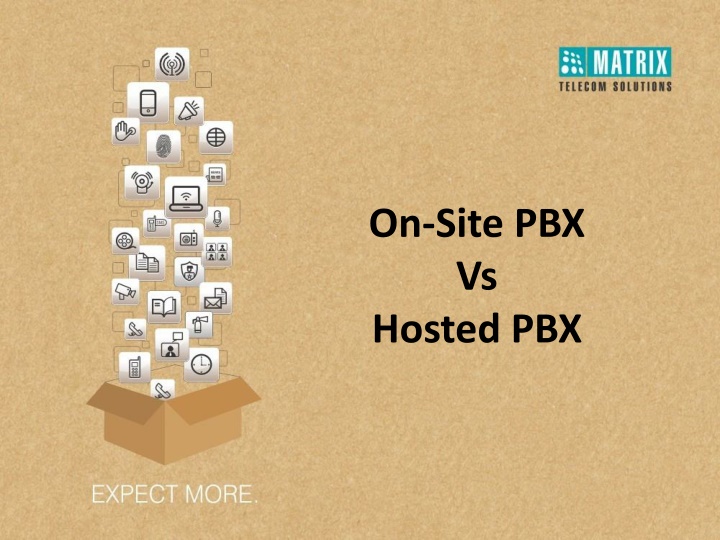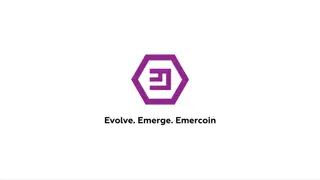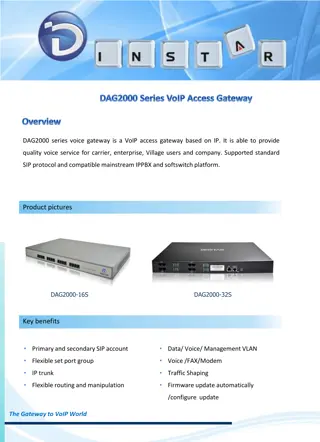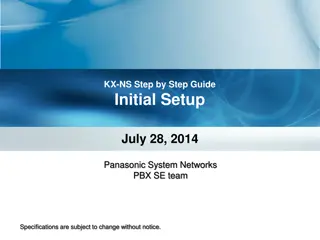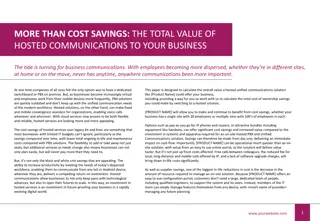On-Site PBX vs Hosted PBX: A Comprehensive Comparison
On-Site PBX and Hosted PBX are two telephony systems with distinct features and benefits. On-Site PBX is a physically wired switchboard system, offering call management capabilities within a business's network. In contrast, Hosted PBX is a cloud-based solution that requires no physical infrastructure and provides flexibility, easy installation, and affordability. The comparison covers aspects such as system control, security, backhaul, compatibility, customization, upgrades, and API integration, highlighting the differences in flexibility, control, security, backhaul, and compatibility between the two systems.
Download Presentation

Please find below an Image/Link to download the presentation.
The content on the website is provided AS IS for your information and personal use only. It may not be sold, licensed, or shared on other websites without obtaining consent from the author.If you encounter any issues during the download, it is possible that the publisher has removed the file from their server.
You are allowed to download the files provided on this website for personal or commercial use, subject to the condition that they are used lawfully. All files are the property of their respective owners.
The content on the website is provided AS IS for your information and personal use only. It may not be sold, licensed, or shared on other websites without obtaining consent from the author.
E N D
Presentation Transcript
On-Site PBX Vs Hosted PBX
On-Site PBX 1. Private Branch Exchange is a physically wired switchboard system that routes external calls to a series of internal phone lines. 2. This technology also offers capabilities such as fax, voicemail, automated voice messages, and conference calling. 3. Businesses have traditionally used PBX systems to organize the volume of calls they receive and reroute them to the appropriate departments
On-Site PBX 4. Once a call enters the PBX, the caller reaches someone within the network by dialing just a few numbers, commonly referred to as an extension. 5. It is the most common PBX, manages the call easily and compatible with most of the old systems.
Hosted PBX 1. It is a hosted telephony system used by a business to route external calls through a network of internal phone lines. 2. Virtual PBX is software based and a new technology, totally IP based. 3. Hosted PBX companies handle call routing, or switching, at their own location.
Hosted PBX 4. They are responsible for managing all of the PBX equipment and software involved in virtual PBX service. 5. It is totally software based. 6. It offers easy installation, very much affordable and provides many features. 7. It works with any VoIP, SIP compliant IP phone, analog phone or softphone.
Difference On-Site PBX Hosted PBX 1. Flexibility Can switch to any vendors at will with PSTN lines availability 2. Control Full system control is with the users 3. Security More Secured device with least possibility of hacking 4. Backhaul Can keep local site calls within your own network saving significant bandwidth 5. Compatibility Compatible with most old systems saving cost for the new systems 1. Flexibility Switching venders is difficult due to configuration of service providers 2. Control No control is with the users 3. Security Always a threat of hacking and reliability 4. Backhaul Places all calls on internet even the internal calls leading to wastage of bandwidth 5. Compatibility Not compatible with the old systems which leads to new system installation and increased cost
Difference On-Site PBX Hosted PBX 6. Customization System can be customized according to need 7. Upgrades Upgrades at will anytime 8. Integrable via API/network Totally Integrable via API/ network so that other softwares can collaborate with it 9. Direct Access Users have direct access to the system 10. Compatible with PSTN Contain ports for PSTN lines 6. Customization Only fixed set of services available at the user s end 7. Upgrades Has to depend upon the service provider 8. Integrable via API/network Not integrable via API/Network so the other application cannot have any collaboration with it 9. Direct Access Has to go through the service provider 10. Compatible with PSTN No ports for PSTN lines
Difference On-Site PBX Hosted PBX 11. Call quality Its IP based so delays, jitters and dropped packets can occur if internet is not speedy enough 12. Fax calls No PSTN lines so Fax calls can have issues as internet speed can fluctuate anywhere anytime 13. Cost As the no. of users grow large the per-user pricing model will become expensive 14. Stability Systems may become unstable having some bugs as it is software based. 15. Encoding No control over the encoding so it depends upon the service provider for the bandwidth and quality, it usually provides G.729 but may switch to G.711 11. Call quality Dedicated circuit for all calls, leads to no network delays, jitter and dropped packets 12. Fax calls Fax calls are better with PSTN lines as they are sensitive to the network fluctuations 13. Cost As the no. of users grow large the cost of local PBX and shared voice trunk will be less 14. Stability Systems are highly stable and reliable as it is hardware based 15. Encoding Has control over the encoding, may select higher bandwidth, higher quality G.711 and lower bandwidth, lower quality G.729
Examples Scenario 1 :- SMB A company including 50 local workers that speak to each other on the telephone extensively. However, the company has limited bandwidth that only supports five concurrent calls. Solution: An on-site system that will route internal calls locally, freeing up the bandwidth to support incoming and outgoing non-local calls.
Examples Scenario 2 :- SME A manufacturing plant of 200 staff members with 100 pre-existing cabled analog handsets already patched. The company does not wish to lose their investment in the 100 handsets and cabling. Solution: An on-site hybrid system linking the existing handsets and adding new IP possibilities.
Summary Hosted PBX Owned, operated, and hosted by the service provider off-site. On- Site PBX PBX present at local site, all functions and features in control of user.
Summary To summarize this is one go we can say that On-Site PBX is better than Hosted PBX specially in:- 1. Compatibility with old systems 2. PSTN port availability 3. Call bandwidth control 4. Direct control over system 5. Security 6. Call quality
